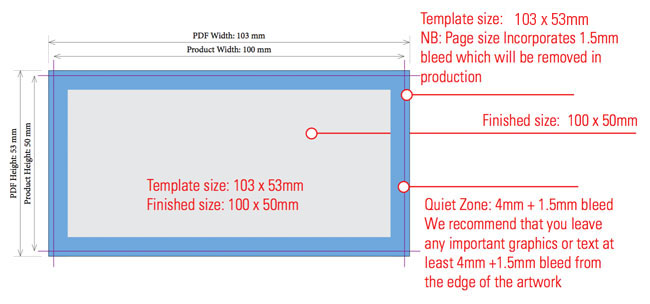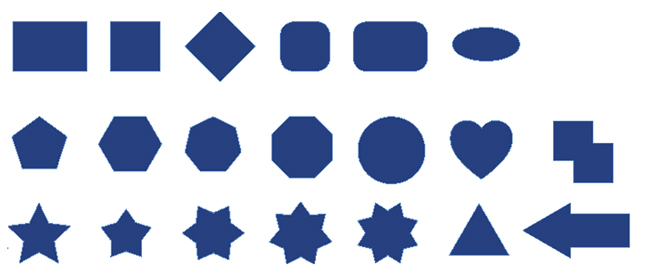Scratch card artwork guide – Hints, tips and specifications
Step 1: Decide on the type of game or cards that you require
- ‘Design A Game’ scratch cards
- Classic ‘5 Way Hot Card’ Game
- Classic ‘5 Way’ Game
- Bespoke ‘Multi-Winner’ Variable Game
- Unique Numbered/Personalised Cards
[row][column size=”1-3″]
‘Design A Game’ scratch card variations
You can order different card variations and combine them to create your game.
Cards must be chosen from one of our standard sizes but there is no limit to the number of variations or the quantity per variations.
For example you could have a game with just 4 variations and the following quantities:
- 125 × variation A
- 500 × variation B
- 1000 × variation C
- 5000 × variation D
Quantities start at just 125 (regular and business card sizes only) or 250 (all other sizes) and are available in multiples of 250 upwards.
[/column]
[column size=”1-3″]
Classic ‘5 Way Hot Card’ Game
These are available in multiples of 1010 cards (Regular or Super sizes).
A minimum order for 1010 would consist of 5 variations with the following quantity split:
- 250 × variation A
- 250 × variation B
- 250 × variation C
- 250 × variation D
- 10 x Hot Cards (variation E)
For larger quantities, the batch increases are in amounts of 1010, i.e. 2020, 3030, 4040, 5050 etc.
[/column]
[column size=”1-3″ last=”1″]
Classic ‘5 Way’ Game
These are available in multiples of 1250 cards (Regular or Super sizes).
A minimum order for 1,250 would consist of 5 variations all with equal quantity splits:
- 1250 × variation A
- 1250 × variation B
- 1250 × variation C
- 1250 × variation D
- 1250 × variation E
Larger quantities are available in batches of 1250 (i.e. 2500, 3750, 5000 etc)
[/column][/row]
[row]
[column size=”1-2″]
Bespoke ‘Multi-Winner’ Variable Game
This solution is usually more suited for larger quantities and/or many variations. With this format you can vary the number of winning/losing combinations to your exact requirements and quantities for each variation:
e.g. A print run of 15,000 cards could consist of:
- 150 × variation A
- 150 × variation B
- 500 × variation C
- 1700 × variation D
- 2490 × variation E
- 10,000 × variation F
- 10 x variation G Cards
[/column]
[column size=”1-2″ last=”1″]
Bespoke ‘Numbered/Personalised’ Game
With this format each card is individually personalised – usually with a unique number or code. This is ideal for Vouchers, Games where you want participants to claim a specific prize, or where a user needs to register online and the unique code is relevant to that process.
e.g. a 5000 print order could be made up of 5,000 unique winning cards
[/column][/row]
Supply of finished Printed Goods
‘Design A Game’ & ‘Classic 5 Way Games’: During the printing process the variations are kept separate from each other and are then banded separately before despatch. For easy identification, the top card of each bundle has an identifying mark or no latex panel.
Bespoke Games & Numbered/Personalised Games: We can supply the cards to your specific requirements, such as banded in individual batch groups, shrink wrapped, pre-mixed randomly or pre-mixed to exact quantities.
DESIGN SPECIFICATIONS:
‘Design A Game’ & ‘Classic 5 Way Games’
InDesign templates are available to download below for each version. Please Note: Our InDesign templates incorpoarte 1.5mm bleed within the page size which is then trimmed at finishing. This is important to consider when placing graphics and text in your design.
- Regular Size: 103mm wide, 53mm high, and trimmed to 100mm wide x 50mm high. DOWNLOAD INDESIGN TEMPLATE >>
- Super Size: 138mm wide, 100mm high, and trimmed to 135mm wide x 97mm high. DOWNLOAD INDESIGN TEMPLATE >>
Bespoke ‘MULTI WINNER’ or ‘INDIVIDUAL ID’ Games Card Sizes
These can be designed to any size you like, however most jobs tend to use one of the standard printing sizes: Business card (88 x55mm), A7, A6, A5, DL, etc.
Designing your Variations – Classic 5 Way Games
For standard games our InDesign template files contains 10 pages which will correspond to the 5 fronts and 5 backs for the 5 the variations.
- Page 1 is the front of variation A
- Page 2 is the reverse of variation A
- Page 3 is the front of variation B
- Page 4 is the reverse of variation B
- Page 5 is the front of variation C
- Page 6 is the reverse of variation C
- Page 7 is the front of variation D
- Page 8 is the reverse of variation D
- Page 9 is the front of variation E (This is the Hot Card for the Classic HOT CARD Game)
- Page 10 is the reverse of variation E
Designing your Variations – Bespoke Games
MULTI WINNER Games: Please supply a separate piece of artwork for each variation. e.g. for a game with 10 variations, we would require an InDesign file with 10 fronts and 10 backs.
INDIVIDUAL/PERSONALISED GAMES:The nature of this game is that there is usually 1 common piece of artwork for all variations with a space allowed on the print for a unique code number. Please supply 1 piece of artwork for the front and back. PLUS a separate CSV file with all the individual codes.
Graphics areas and recommended Quiet Zones
When designing your card, ensure that no important text or graphics are positioned too close to the edges where they could be trimmed off when finished. Our Standard Game templates incorporate a recommended 4mm ‘Quiet Zone’ + the 1.5mm bleed. Use this as a guide to position your graphics

Latex Scratch Panels
Production will overlay a silver-coloured latex panel onto the area that you indicate as the latex panel. This is done in the artwork using an appropriate shape using the ‘DIE CUT FORME COLOUR’ as a fill. For artwork that does not use one of our templates, please use a ‘SPOT COLOUR’ for colouring the intended latex/scratch area.
Please Note The latex is applied using a screen printing process, and registration can vary by around 1 mm.Ensure the latex does not encroach too closely to anything important.
To achieve an assured result, there are various restrictions that need to be adhered to when specifying the latex panel on the artwork:
- Simple shapes are allowed for the scratch panels. These include squares, rectangles, circles, diamonds (see examples below).
- You may position any number of scratch panels anywhere on the front of the design with a minimum space of 4mm between each.
- The latex panel should not be blEed off the edge of the artwork,
- Scratch panels are recommended to not encroach into the quiet zone.
- Latex scratch panels should overlap the grey background by 1 mm on each edge, and be centred over the background of the scratch area.

The smallest shape recommended is 10mm square. Anything smaller is produced at your risk as the process becomes unpredictable.
Avoid:
- acute angles,
- corners with a small radius.
To avoid the end-customer seeing the image under the latex, there are recommendations on preparing the artwork under the scratch panel:
- The background should be 20% black or 100% yellow
- Graphics should use only tints of black, between 30% and 65%.
- Text should only use a black 65% tint.
- The position and size of the latex scratch panel is indicated with a solid overprinted DIE-CUT FORME COLOUR (OR Spot Colour) shape.
- Make sure your artwork under the scratch panel has suitable contrast – i.e. don’t use 8pt type in 30% black and expect it to be visible!
Reverse artwork
The reverse of a Scratch Card may be in full colour CMYK. For Standard Products the reverse is uncoated and highly absorbent uncoated paper, which can be prone to setoff
when large blocks of solids are used.
For the best results we recommend avoiding the use of heavy solids, i.e avoid using;
- Blocks of 100% Black, on the reverse.
- large text ur thick lines
- When using black it should be limited to 80% black (this has an almost black appearance).
- Larger areas of ink coverage (over 5mm square) such as large bold text, graphics and images should be limited to 50% tints.
- In addition, the heat of the latex process can cause such areas to become tacky and attach themselves to the glossy front of the sheet beneath it in the pile
Security
‘Design A Game’ & ‘Classic 5 Way Games’ Security These game formats’ production is not a high-security process and is not recommended for prizes of high value.
Bespoke Games Security We can build in certain security features to help prevent fraud. Please contact us on 01282 865333 for further information.
Other Do’s & Dont’s for a perfect result
- Convert all colour images and graphics for the fronts to CMYK
- Convert all text to outline
- Convert all spot colours to CMYK
- For any eps files, ensure any text is converted to outline and Pantone colours are converted to CMYK
- Respect the quiet zone – Do not position important elements such as text too close to the edge – 4mm minimum to the finished edge is recommended
- Ensure the latex panel artwork extends the artwork underneath by 1mm
- Ensure a consistent position for graphics and latex panels
- Check intensity of tints under latex panels
- If in doubt, contact our studio on 01282 865333
